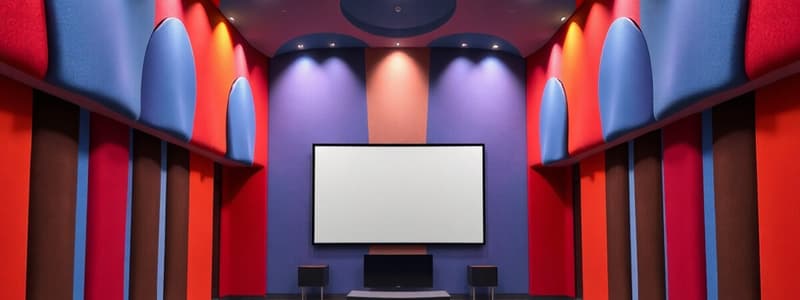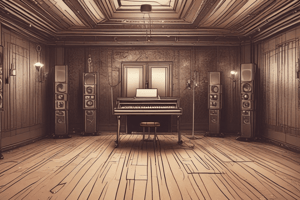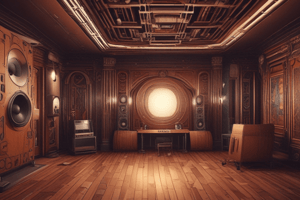Podcast
Questions and Answers
Class C is composed of small granules or finely divided particles of mineral or vegetable origin with an incombustible mineral ______.
Class C is composed of small granules or finely divided particles of mineral or vegetable origin with an incombustible mineral ______.
binder
Class A units act as a covering and support for the sound absorbent material, making them strong, durable, and ______.
Class A units act as a covering and support for the sound absorbent material, making them strong, durable, and ______.
rigid
Type I units have a perforated surface, with the perforations arranged in a regular ______.
Type I units have a perforated surface, with the perforations arranged in a regular ______.
pattern
The selection of the ______ is the first step in planning for good acoustics.
The selection of the ______ is the first step in planning for good acoustics.
The ______ time should approach the optimum characteristics for effective acoustics.
The ______ time should approach the optimum characteristics for effective acoustics.
Noise survey is a critical step in the ______ for good acoustics.
Noise survey is a critical step in the ______ for good acoustics.
Class B units are characterized by circular ______ extending into the sound absorbent material.
Class B units are characterized by circular ______ extending into the sound absorbent material.
Type IV units include products like Q-T Ductliner and ______.
Type IV units include products like Q-T Ductliner and ______.
Proper sound-______ is crucial for reducing unwanted noise.
Proper sound-______ is crucial for reducing unwanted noise.
The arrangement of the ______ is important for achieving good acoustics.
The arrangement of the ______ is important for achieving good acoustics.
The distribution of absorptive and ______ materials contributes significantly to acoustics.
The distribution of absorptive and ______ materials contributes significantly to acoustics.
Acoustical ______ are used to improve sound quality in a room.
Acoustical ______ are used to improve sound quality in a room.
Acoustical ______ are made from materials like mineral wool, glass fibers, and hair felt.
Acoustical ______ are made from materials like mineral wool, glass fibers, and hair felt.
Flashcards are hidden until you start studying
Study Notes
Planning for Good Acoustics
- Eleven Steps: Site selection, noise survey, room arrangement, sound insulation, noise control, room size, distribution of materials, installation supervision, sound amplification, inspection, maintenance instructions.
- Requirements: Noise reduction, room shape/size, ideal reverberation time, appropriate acoustic materials.
- Speech and Music Rooms: Freedom from noise, proper shape, sufficient sound level.
Room Design
- Floor Plan: Shape and dimensions.
- Elevation of Seats: Optimize audience listening.
- Ceilings: Shape and materials affect acoustics.
- Side Walls: Affect sound reflection and absorption.
- Rear Walls: Sound reflection and absorption.
- Balcony Recess: Shape and location impact acoustics.
Acoustical Materials
- Categories: Pre-fabricated, acoustical plaster/sprayed, acoustical blankets.
Pre-Fabricated Units
- Types: Acoustical tile, perforated units with absorbent backing, wall boards, tile boards, absorbent sheets.
- Type I (Cast Units):
- Class A: Mineral units with Portland cement binder.
- Class B: Mineral units with lime or gypsum binder.
- Class C: Mineral or vegetable particles with incombustible mineral binder.
- Type II (Perforated Units):
- Class A: Perforated surface covering with sound absorbent material, durable.
- Class B: Circular perforations extending into absorbent material.
- Class C: Slots or grooves extending into absorbent material.
- Type III (Fissured Units):
- Class A: Long wood fibers.
- Class B: Fine felted vegetable fiber or wood pulp.
- Class C: Mineral fibers.
- Type IV: Q-T Ductliner, Celotex, Corp.
Acoustical Plaster and Sprayed
- Types:
- Plastic and porous materials applied with a trowel.
- Fibrous materials combined with binder agents applied with a spray gun or blower.
Acoustical Blankets
- Types: Mineral or wood wool, glass fibers, kapok batts, hair felt.
Studying That Suits You
Use AI to generate personalized quizzes and flashcards to suit your learning preferences.




